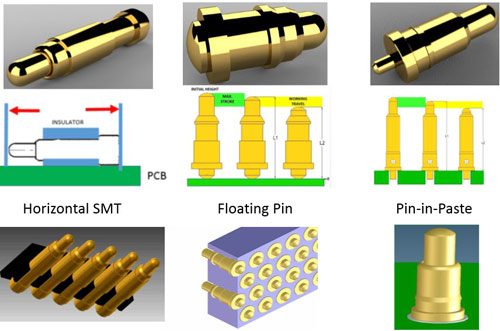 Probably the fastest growing type of interconnect being used by engineers is the spring-loaded contact. Spring-loaded contacts (aka SLCs) are ideal for creating solderless interconnections between mating modules, such as a handheld instrument to docking station, instrument to recharger, stacking PCBs, etc.
Probably the fastest growing type of interconnect being used by engineers is the spring-loaded contact. Spring-loaded contacts (aka SLCs) are ideal for creating solderless interconnections between mating modules, such as a handheld instrument to docking station, instrument to recharger, stacking PCBs, etc.
SLCs are ideal for new product design for the following reasons:
1. They’re forgiving to stack-up tolerances and uneven mating surfaces.
2. They’re ideal for blind mating applications—the SLC only needs to mate to a gold-plated PCB land.
3. They’re extremely easy for engineers to use.
Typically the words Pogo and SLC are loosely interchanged by the engineering community. I am used to the phrase pogo, to describe a type of SLC with a hardened Beryllium Copper piston that is chisel, tulip, waffle, or pointed. These types of SLCs are used for piercing through dielectric surfaces (such as oxidation). These types of SLCs are traditionally used in Bed-of-Nails test beds, for high-cycling repetitive testing.
The other type of spring-loaded contacts have radius tipped pistons. Some manufacturers use BeCu, others use Brass. These types of SLCs are used in the docking station, recharging station, and stacking type applications.
There are countless manufacturers who make SLCs. Below you will find three uncommon styles and the advantages of each.
- Horizontal SMT SLC – Ideal for low-profile design, a good example is LED lighting strips, which are typically daisy-chained to increase length.
- Floating Pin SLC – This type of SLC is assembled into a molded cavity that permits vertical float, which will help it in applications upon uneven surfaces. This style SLC is ideal when used as an interposer between a top and bottom PCB when both PCBs will be mechanically clamped down together. This product achieves solderless interconnection.
- Pin-in-Paste SLCs – With the evolution of SMT assembly, emerging is the concept of assembling traditional through-hole components now using high-speed SMT pick-and-place. Assembling a through-hole component onto a SMT board is called intrusive-reflow or pin-in-paste. Simply, there is a through hole on a SMT board and solder paste is screen along the annular ring of the land. The through-hole component is reflowed soldered from the top side, instead of a solder fillet to a tail on the bottom like traditional wave soldering. Pin-in-Paste SLCs feature a short stubby tail (typically less than 1.5 mm in length), a tail purposely intended not to protrude beneath the PCB. Since the Pin-in-Paste SLC does have a tail, it naturally becomes much mechanically stronger than just a SMT SLC, and it has bulls-eye alignment, since the SLC cannot migrate on the PCB land during reflow.
Martin Houlroyd is Principal Engineer/Marketing Specialist at Preci-Dip. He has worked in the interconnect industry for 35 years.

Leave a Reply
You must be logged in to post a comment.